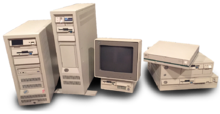Beige box
This article needs additional citations for verification. (July 2010) |


In consumer computer products, a beige box is a standard personal computer (PC). It has come to be used as a term of derision implying conservative or dated aesthetics and unremarkable specifications.[1] The term is ultimately derived from the style of many early personal computers and dedicated word processors, which were usually beige or similar colors like off white or ecru.
IBM's early desktop computers (e.g. IBM Personal Computer, IBM PC/AT) were beige, and box-shaped, and most manufacturers of clones followed suit.[citation needed] As IBM and its imitators came to dominate the industry, these features became standards of desktop computer design.
Early Macintosh models were a beige color (specifically Pantone 453). Although Apple switched to a desaturated gray they called “Platinum” in 1987, users began to refer to them as “beige” following the introduction of the brightly colored iMac in 1998 and the Blue and White G3 in 1999. It eventually became a standard term to identify any previous Old World Macintosh, such as the “Beige G3.”[citation needed]
While the original Commodore 64 was a deeper brown (specifically, RAL 1019),[2] its second revision in 1986, the C64C, was beige. The German-exclusive minor revision of the original form factor the following year, sometimes referred to as the C64G, combined the new beige color of the C64C with the original larger size case.
The term is also sometimes used to distinguish generic PCs from models made by "name brands" such as Compaq, Dell, or HP. In the early years of these companies, most of their units were beige as well. More recently, as name-brand manufacturers have moved away from beige (typically switching to black, dark gray, and silver-colored cases),[3][4] inexpensive generic cases became more distinct as "beige boxes". Today, the term "white box" has largely replaced this usage.[5]
See also
[edit]References
[edit]- ^ Levine & Young; John R. Levine; Margaret Levine Young (2010). The Internet For Dummies. For Dummies. p. 49. ISBN 978-0-470-56095-2.
- ^ "Matching Commodore breadbin beige". dfarq.homeip.net. 28 August 2019. Archived from the original on 2019-08-29. Retrieved 2021-01-05.
- ^ Lohr, Steve (2002-04-18). "The Beige Box Fades to Black (Published 2002)". The New York Times. ISSN 0362-4331. Retrieved 2021-01-05.
- ^ Spooner, John G. "PC makers look beyond the beige box". ZDNet. Retrieved 2021-01-05.
- ^ Ross, John; Murdock, Kelly L. (2007-03-12). PC User's Bible. John Wiley & Sons. ISBN 978-0-470-08897-5.
